
Max Bill
“And he said, Hear now my words: If there be a prophet among you, [I] the LORD will make myself known unto him in a vision, [and] will speak unto him in a dream.”
Numbers 12:6
” He asked me what sort of patients they were. I answered that in most cases they suffered from mystic delusions. After reflecting for a moment, Firth said to me that it was obvious from a logical point of view that, if in their delusions they were in contact with mystic figures, they could not accept my presence, since I was simply a human being.”
Salomon Resnik (Logics of Madness)
“It is my experience that in psychoanalytic writing, as in poetry, a concentration of words and meaning draws on the power of language to suggest what it cannot say.”
Thomas H. Ogden (The Art of Psychoanalysis)
“I have looked down the saddest city lane.
I have passed by the watchman on his beat
And dropped my eyes, unwilling to explain.
I have stood still and stopped the sound of feet
When far away an interrupted cry
Came over houses from another street”
Robert Frost (Acquainted with the Night)
I wrote before about this sense of a generalized PTSD that contemporary western society seems to suffer from. Nearly everyone, I think, experiences some degree of this (what I called) ‘batterment’.
“These difficulties are evident in overtly psychotic patients, but in this paper I shall deal with another category of patients who can be very difficult to treat: neurotic patients who possess autistic barriers or autistic nuclei (S. Klein, 1980; Tustin, 1986). These patients do not present the severe symptoms of the most serious cases, and their cognitive functions are in some areas usually well preserved. Nonetheless, the challenge they pose is that they suffer from a deficiency in their capacity for thinking, which originates in traumas that are filed in the so-called ‘inaccessible unconscious’. Although limited, this deficiency is significant enough to determine subtle situations of impasse in the analysis.”
Giuseppe Civitarese (Truth and the Unconscious in Psychoanalysis)
Civitarese is writing about patients who have difficulty with symbolization. Patients who cannot give personal meaning to their experience. In some cases the meaning they work with is pre-fabricated, and I think there is a degree of this in nearly everyone living under advanced capitalism. There is a fair amount of literature on childhood amnesia, and more on the very earliest memory, or memory traces, archaic and non-repressed mnestic fragments, or not even fragments but something like slivers of fragments which are usually associated with trauma and largely inaccessible. And because they are of necessity non representational, they begin to resemble quarks or other late quantum theories that are mostly purely theoretical.
“It is my assumption that representational deficits connected with preverbal traumas that generate autistic or psychotic nuclei in the patient’s personality ‘force their way’ towards a stage of prerepresentability via projective identification, action and enactment. In particular, I believe that they speak ‘semiotically’: unlike ordinary repressed memories, they can emerge almost exclusively in the form of disturbances in the setting.1 While such disturbances are most commonly thought to involve enactment and forms of action, they can also present themselves in a general feeling of blankness and deprivation; in a poverty of discourse or the relative incapacit.”
Giuseppe Civitarese (Ibid)

Bartolo di Fredi (1356, Joseph’s Dream)
In contemporary populations I suspect there is a high degree of substitution experiences; borrowed rather than developed in early pre-linguistic infantile processes with the caregiver. If the Mother or Father are themselves fragmented or suffer deficit in symbolization then the infant can only find obsessive routes to protect itself.
“The capacity to coordinate the senses is not fully developed at birth, but is strengthened through the introjection of a positive relationship with the caregiver and the process of somato-psychic integration that follows. When the senses are dismantled, these patients retreat to an illusory sense of continuity of their Self, which has not yet been confronted by the awareness of the separateness of the other – an experience that for them would trigger an unbearable feeling of dread.”
Giuseppe Civitarese (Ibid)
Such patients never bring dreams to their analysis but simply repeat boring narratives, devoid of color or feeling. A bit like TV. Civitarese describes sessions with patients who tell these ‘boring lifeless stories’ to be a good deal like death. The walking dead. A television formula for this urge to repeat.
“Utopia possesses a place in the ‘nowhere’ and it may be conceived as a different dimensional register. However, what is sometimes met with in both dream thought and in insane thought may not correspond to the usual idea of place, of dimension and time, but be constituted as another, atopical and achronic reality.”
Salomon Resnik (The Theatre of the Dream)
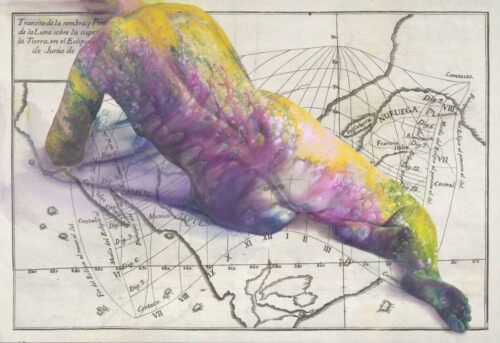
Firelei Baez
After the podcast on TV, film, and culture (#142) I started to think more on the question of speech, of text, and of dreams. Art is always intwined with dream life and dream work. Resnik noted the dream turns the unconscious into discourse. And this in turn made me think of ‘other minds’ (per Peter Godfrey-Smith), animal minds, and our own mysterious infancy. Our pre linguistic psyche and why we learn to speak WHEN we learn to speak. There has always been a question around the lack of speech in higher primates. Chimps are very smart, and at five months old are of the same intellect as humans at the same age. Why can’t they speak? Well, that question goes back to Darwin, who thought they simply lacked the intelligence. And this is still partly the answer scientists will give you. Others thought, for years, that apes lacked the anatomy. But this has been somewhat discounted now. They ‘could’ speak if they chose, so to speak (sic), but no amount of prompting or education will or can teach a chimp to speak.
And the reasons remain mysterious for the most part. https://www.sapiens.org/language/primate-speech/
But there are other more philosophical issues that science seems to avoid. Its one thing for a parrot to mimic speech. It is another to engage in complex discussions, or to develop an alphabet and write out complex thoughts. What interests me here though is related more to aesthetics. And to the human psyche.
“The classic theory of the dream in Freud uses the notion of the dream screen. In this book, on the other hand, I speak of ‘stage’ and of ‘theatre’: the same dream is a film or theatre stage depending on whether one dreams with one eye or with both eyes. The person recounting the dream becomes the theatrical director who, on waking, will re-create the new version of the dream: it is another stage, another space-time (the ‘transference’ in analytical experience). The narrative of the dream is a dramatization, a different interpretation…”
Salomon Resnik (Ibid)
This is very close to what I have written before about the unconscious, and its relation to our imagination.
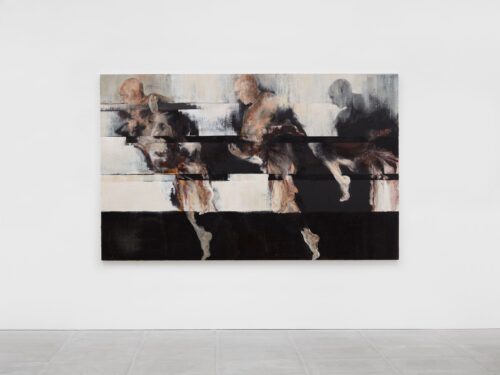
Patrick H. Jones
“It is difficult not to take into consideration these two ‘monocular’ characters without linking them to the dream of The Interpretation of Dreams: ‘to close one eye’ means to identify oneself with the physician-father and the teacher-father who represent the monocular or ‘flat’ position of the dream. From the phenomenological point of view, the three-dimensional version is affectively more vivid; it even attains colour and sound in the dream. (In a conversation, Borges also talked to me about the sound dreams of the blind.) On the other hand, in cases of depression or excessive emotional blockage (psychosis), both dreams and the emotional world are flattened; there is a correspondence here with certain individuals’ ‘monotonous’, detached tone of voice. “
Salomon Resnik (Ibid)
This explains, to a degree anyway, the emergence of cinema and its dominance as an art form for the last hundred years. But again this is not really what interests me here, though it IS related. And one can intuit the quality of ‘detached tone of voice’ in contemporary society. In contemporary film and TV we are getting narratives (and cinematography) more closely associated with the monocular. The cinematic backdrop to our culture is one of a depressive or of the autistic, in a very mild form (if such a thing actually exists). And this is partly the result of eroded language skills. Its a bit like Chimps are making our movies now. But it is also the result of a more acute inability to access the unconscious.
Freud wrote of dreams as personal myths, and myths as societal dreams. The role of silence in treatment, in clinical settings, looms as hugely important. Civitarese writes how he often feels as if he is in a Beckett play. And this observation is very telling, I think. In Pinter, too, of course, silence is an elemental ingredient in the dialogue. And I began to wonder, as I noted in the podcast, about the noise of contemporary society. (and reminded me again of one of my favorite documentaries, Into Great Silence, made by Philip Gröning, about the Carthusian monks of the Grande Chartreuse, a monastery in the French Alps). How does our earliest archaic memory traces incorporate silence? Silence is a part of speech.

Jean Lecomte du Nouÿ, (A Eunuch’s Dream, 1874)
“We can thus perceive an aspect of O (Bion, 1970) – ‘the name of that which has no sound, smell and texture … of what there is before our senses tell us what it is’ (Vitale, 2004) – as a knowable, phenomenal reality. The bundle of unprocessed, non-representable proto-emotions from which mental pain originates is gradually disentangled. The patient’s psyche is reinstated into the body and its wounds stop bleeding. The contact barrier is restored together with the binocular functioning (conscious/unconscious) of the psychoanalytic function of the personality – the shades protecting our retinas from the blinding glow of the Real.”
Giuseppe Civitarese (Ibid)
“…the fundamental heritage of the classic view, which conceives of ‘the dream as a message’, a complex, vital message. The technique of the ancient oneiromancers, including Artemidorus, consisted of translating into conventional, comprehensible language the hidden, ‘mysterious’ meaning of the dream discourse.”
Salomon Resnik (Ibid)
And I think Resnik is right (he is suggesting Freud’s early dream theory was reductive to a degree. The hallucinatory quality of unconscious wishes, of dreams, begs the question of ‘who’ is dreaming; the super-ego? The Id? Instinct or drive or something else? Or is the idea of a ‘who’ itself an illusion? One of the comments on the podcast was related to Tarkovsky and his film Stalker, and how to interpret ‘desire’. And how is this idea related to our earliest pre-linguistic memory traces?

Cover of Degenerate Art Catelogue.
And here, in aesthetic terms, the idea of a climate or sensibility of Being is raised. Again, cinema was used extensively by mid century fascism. The role of myth, of an ideologically mediated mythology was hugely significant for National Socialism, and for Mussolini government. “The internal world lives in representation, in Vorstellung: Vorstellung, then, is a theatrical representation; the stage is that part of the theatre where the actors (Darsteller) act and where the sets that create the atmosphere of the production are placed. The dream stage may be vast, tiny, superficial, or deep… The characters of the dream, the actors, come on to the stage and present themselves to public view. The dreamer is also the public that sees, listens, and perhaps even recounts, if he remembers it, the representation of his dream. The actors of the dream make their exits and their entrances, appear and disappear as on the stage of a theatre. The sets are the landscape of the dream, and its shape and colours form part of the Bildsprache.”
Salomon Resnik (Ibid)
That the dreamer is also the audience, the public, is critically important I think when we extrapolate to the contemporary culture. The idea of ‘audience’ is not the same as it was 100 years ago. This is just one of the significant changes in how our subjective understanding of ourselves has changed. There is less resistance to the idea of being an actor in one’s own play, or rather more likely in one’s own movie. And in a sense many if not most people see themselves, positively, as actors in a semi-private performance. Reality shows, I would argue, have had an indelible imprint on our interior ideas of identity. And as parenting has become more ‘remote’ and families disintegrating earlier and parents working longer and more stressful jobs, the psychic development of the child is increasingly interrupted. Even highly educated children seem to exhibit a kind of monocular vision of a flattened emotional world. As social media is now awash in Jihad ‘snuff films’ (US paid for and supported, and Israeli supported) the cruelty index has shifted to never before seen levels of brutality. (it does occur to me that the push for censorship in the US and EU welcomes these snuff films. Probably encourages the Takfiri jihadists to film everything).

Vittore Carpaccio (Saint Ursula’s Dream. 1495. )
The public in general tend (more and more) to undervalue text in both film and theatre. Watching the old productions of Pinter’s The Caretaker (with Robert Shaw and Donald Pleasance) was to be reminded that text is foregrounded in Pinter. It is a form of thinking on stage (as Murray Mednick once pointed out). And as Jan Kott also emphasised. And one must listen to what isn’t said. The shape of the play is led by the speech. By the dialogue. This is much harder in cinema and nearly impossible in TV. The Robert Wilson effect has meant theatre represents itself as film, and the noise has gone internal. Its not gone, despite how quiet is Wilson. In a way the blankness of those stone walls in Bertolucci reflected the inner blankness of the character, and this became the soundtrack quiet of Malick, where quiet was just quiet, it was absence of something. And this was akin to the visual compositions of Wilson (David Lynch plays into this discussion about here) which also pointed toward absence. The ultimate malevolence of absence was Abramovic sitting and silently counting her earnings. The silence of late stage Biden, the alzheimer mutedness also reflected a collective media ‘pleading the fifth’ on Covid, on Gaza genocide, and Hunter’s laptop. The silence of Jeffrey Epstein’s suicide (my guess is he is still alive, but never mind) and the invisible ink in Ghislaine’s little black book. Biden became a kind of Beckett play. The oval office as a set for Endgame.
Hunter Biden and Epstein, and to a degree P.Diddy and Jay Z are the avatars for a ‘new man’, with autistic nuclei, with psychotic impulses, with something noticeably missing in their personalities. Noise became a morbid silence. The steep increase in Alzheimers and Autism cannot be ignored away. The noise of the 80s did not disappear, but was heard as if through headphones, privately, by a public steeped in paranoia. The Imperialist snuff films in Syria now are just one fissure in a aging psychic reactor where the redline was reached a decade ago. The psyches of these people are like spent fuel rods. The public listen through their invisible headphones to the screams of Palestinian children and are paralysed, mentally and physically. They listen and stop hearing. Nobody can keep hearing.
“A person consults a psychoanalyst because he is in emotional pain, which unbeknownst to him, he is either unable to dream (i.e. unable to do unconscious psychological work) or is so disturbed by what he is dreaming that his dreaming is disrupted.To the extent that he is unable to dream his emotional experience, the individual is unable to change, or to grow, or to become anything other than who he has been.”
Thomas H. Ogden (Ibid)
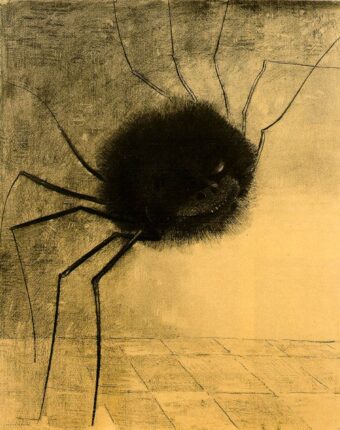
Odilon Redon
“As in the theatre, the dream is acted out and the author’s discourse is unveiled through the dramatization of his characters. In the Greek theatre there were masks to express every mood: the actor had to ‘bear’ the traces of his feelings: sadness, joy, or irony…What is shown is the implicit expression of what is present beyond appearance. There is a mediation between the actor and the public: the author’s mask. I am using the theatre as a ‘true’ metaphor in order to speak of the interpretation of the theatre of dreams; the place where the actors dramatize the dream is the dream stage. The notion of stage and dramatization brings the three-dimensional perspective of the dream at the spatial level, or four-dimensional perspective if one includes the rhythm of the play as an idea of time. The theatrical conception of the dream diverges from the two-dimensional conception of the dream screen. The notion of the dream ‘screen’ was introduced by B.Lewin to suggest the projection of the dream on to a white screen, which symbolizes the mother’s breast.”
Salomon Resnik (Ibid)
The new obsession with LED lighting reminds me of several passages in Tanizaki’s In Praise of Shadows, on the importance of shadows and dark corners in Japanese homes, but also I remember once Werner Herzog complaining of Americans need for everything to be over-lit. There is no theatre if the lights never dim. Dreaming is much harder.

Claire Chesnier
The erasure of very early memory traces is almost a Schrödinger’s cat for psychoanalysis. But this also leads along a path that has to address the very idea of a self. But first, if I am positing that contemporary society has evolved inherent pathology at the earliest stage of psychic development or formation has several implications, it seems. One is that on a societal level the contemporary population of the West is increasingly trending toward generalized autism. And Debord said that sixty some years ago. But this raises other questions. The traumas of pre-linguistic infants are difficult to know or even describe hypothetically. Laplanche saw the unconscious itself formed by those inarticulate messages of the mother to the baby during nursing (primarily). Lacan was very focused on our core sense of Being involving a field of relationships, of sociality.
“Thus the natural propensity to transference which Freud attributes to dream can be found again in Ada’s impulse to tell her trauma and its connected dream, not only to me, but repeatedly to herself and potentially to everyone. In this way she tries to repair the alliance with the other out of which she was born as a subject, and which now feels ruined. As Ogden (2005) splendidly suggests, the model for all treatment lies in this search. Depending on the gravity of their suffering, patients ask us only to help them to dream the dream that they have never succeeded in dreaming, or to resume the dreaming of their interrupted dreams. After all, this is a matter of regaining contact with the primary object, if it is true that, as Pontalis (1972) maintains, to dream is to be reunited with the mother in a space before time.”
Giuseppe Civitarese (Ibid)
The need to repeat the experience (dream in this case), or rather repeat the narration of the dream, is one of the most profound links to theatre as the Ur-medium. The actors memorize their lines and repeat the performance every night. And this, as a side bar, is one of the things effectively destroyed in contemporary theatre, small theatre, genuine theatre if you will, by economically limited runs of shows. Most theatre artists I know are doing one night, one off, performances. But if you cannot repeat the performance something significant is gone. All playwrights are repeating the narration of their dreams. And here is another important difference from film or TV. And the metaphorical aspect of NOT repeating but only re-running a show is in our psychic theatre of the mind a key problem. The impulse to repeat is short circuited.

Ulrich Wüst, photography.
“The notion of the dream ‘screen’ was introduced by B.Lewin to suggest the projection of the dream on to a white screen, which symbolizes the mother’s breast. In some dreams, called blank dreams, the screen appears alone, without actors, classically representative of primary narcissism. Lewin interprets the dream screen as a symbol of sleep and considers that the dream experience is connected to the child’s earliest experience of his first object, the mother’s breast. “
Salomon Resnik (Ibid)
Here it is worth noting that the silence (that is not silent) of dementia-Biden is to be replaced by a return to noise (Trump). The collective aesthetics of our societal dream (myth) is now a noisy sit com with a laugh track. When on the podcast we discussed the canon of TV series (Sopranos, Breaking Bad, Hannibal, Mad Men, et al) one take away was that all of them existed in an ironic frame, if not outright satire. Whatever the impulse to tragedy, it could only be approached through the ironic. And dreams are not ironic.
But there are different kinds of silence (rather obviously, I suppose). Or registers of silence. And I suspect that the backdrop for society now, in terms of a soundtrack, has returned to noise. And the art that creates silence, as part of the artwork, is a particular kind of silence. A silence that lives within the noise. Those Carthusian monks referenced earlier have, in a sense, found an inroad to a different silence. The noises they hear live within the great silence they have discovered. Now the TV shows we designated as part of this canon were ironic and are burdened with a huge amount of framing devices (so to speak) — the networks, the technology of the screen, the capitalist Spectacle, the ‘entertainment’ industry. And what is interesting is that stuff like Terrence Malick, for all his pretensions to art, is massively mediated by all of the above (Tree of Life starring Brad Pitt for example). So the manufacturing of a deeper listening, a deeper silence, is still one that must travel through the prism of entertainment. Jean Marie Straub and Daniele Huillet made films that were truly outside considerations of entertainment. Bresson did the same, and to varying degrees Dreyer, or a film like Institute Benjamenta, by the Quay Brothers, based on the novel Jacob von Gunten by Robert Walser, is admirably free of most of this framing, or the films of Alain Guiraudie (Stranger by the Lake in particular). But Straub stands as a very particular kind of independent artist of cinema. I happen to like his film of the Shoenberg opera Moses and Aaron (1975). It bears something in common with Bresson’s Lancelot du Lac, but is perhaps even more transcendent. I remember Chantel Akerman calling it ‘exhilarating ‘ and odd as that might sound, it does seem a perfect description. And the silence is pure. The fact that it is an opera would require a lengthy discussion, that we should have one day but not today.

Nicholas Party
Now when I screened Bresson for students at the film school, the first reaction was nearly always negative. By the end of the semester it had changed. It is hard to experience that which is without irony. And I have said this before, that sincerity has become very suspect, and is approached with hesitation today. Abstract Expressionism was the last sincere movement, I think. And art’s relationship to our idea of ‘self’ enters the discussion here. Our idea of something enduring after we die. Something behind or before or in back of our bodies, or our experiencing instrument. The films I noted above are without irony. Another is Mister John ( Joe Lawlor, Christine Molloy, 2013). And I suspect much of what I value in all these films is the lack of irony.
And circling back to the trauma of infancy, to the archaic memory fragments or traces. And there is something here that begs questions of awareness and self. And Kant with the transcendental subject. And with Indian philosophy and the atman. The infant’s experience, which is at first of the mother (it is safe to say, I think) gradually (or suddenly) notices that Mother is not himself or herself, that the nipple is not his or her own auto-source of nourishment and pleasure. And that is troubling (we presume). None of us remember because this happens before we know anything, including language. Now I have written about this very early pre linguistic phase a number of times on this blog because I think this is critical to understanding most everything else that follows. A number of positivist thinkers suggest awareness of anything is automatically awareness of awareness. It’s not true, but I get why its appealing. But all this, especially our language, premises these concepts on a kind of proto ownership of ourselves.
And this is very insidious. The grammar of all romantic languages anyway, is structured to make it easier to think as a property owner. But putting that aside, this early experience remains hidden, the memories hidden, and I suspect the very idea of hiddeneness can be sourced here. Some kind of turning away — forced or voluntary — occurs. Das Ding. For Lacan this is lack itself. For Freud it is an object (the mother, or her breast). But it is a constitutional lack or hole or missing quality that brings desire proper into existence.

Barbara Probst, photography.
Desire means there is a desiring subject. Lacan later referred to this object a. Writing of ‘the thing’…
“Where does It come from? From an unnoticed passage now uncovered in one of Freud’s superseded texts, his 1895 Project for a Scientific Psychology, which was published posthumously and has of late become a gold mine for researchers (Freud 1950.). Lacan was not new to this kind of reading of Freud: even Verwerfung (forclusion, foreclosure) was lifted from one of Freud’s clinical texts. With the Thing, a theoretical text is brought into play, but in both cases Lacan’s procedure is the same: to expand on an undeveloped or implicit meaning. In the passage rescued by Lacan, Freud ponders the origin of knowledge, which he pinpoints in the splitting up of the “primary perceptive complex” (Nebenmensch-the neighbor, the “nearest human being”), which for the child is both a small object of fulfillment and the first object of hostility. This Nebenmensch is split into two components: one reduced through memory to the subject’s information about his own body (hand movements or a cry, for example); and the other, by contrast, new and without paragon (facial features, for example), which “affirms itself through its unchanging apparatus, which remains together as thing, als Ding.” This is the Thing Lacan recovered from Freud’s text, and which had escaped previous commentators: it is “the element initially isolated by the subject, in his experience of the Nebenmensch, as being by its very nature alien, Fremde” (Lacan 1992, pp. 51-2); it is the result of “an originary splitting of the experience of the reality” around which the subject’s entire world of desires will orient itself-his absolute Other which he will spend his life unsuccessfully seeking to refind. It is in reference to it that the subject “is constituted in a kind of relationship characterized by primary affect, prior to any repression” (Lacan 1992, p. 54).
Hence, Freud’s small point becomes, in Lacan, an absence or attracting void of enormous significance, world-founding, much like the Thing of which Heidegger speaks in a lecture quoted by Lacan in this very seminar, and from which he draws the famous example of the vase. For Heidegger, the vase is a model of an original deed: the potter shapes the void which, for Heidegger, holds the “fullness” of water or wine poured to the brim, while the act of pouring from the vase evokes the sacrificial offering of drink to the gods, thus uniting heavenly and earthly powers. For Lacan, the jug’s shape embodies a primordial signifier which creates the void, and so introduces the perspective/prospect of fullness. Thus the jug comes to represent “the existence of the void at the centre of that reality called the Thing.”
Elvio Fachinelli (Lacan and the Thing, European Journal of Psychoanalysis, Vol 8 #1)
What Lacan does not seem interested in is the formation of memory, or of memory traces. He sees the formation of a primal void organized around ‘das ding’ — the thing, the lack, the want that is generated from the lack. The shape of the unconscious in a sense. But there are paradoxes. Freud saw a lost object. Lacan saw a lack but one built around an actual object. Around that which resists symbolization. But what importance does this originary awareness have for our later amnesiac psyches? ( a side bar on Elvio Fachinelli, who died in 1989. A very neglected left wing psychoanalyst who is barely translated at all into English). Lacan by the end of his life, suffering mental breakdown, sat ín front of his classes tying knots. Eventually he stood in front of them, mute. This was our final Beckett play.
This ‘thing’, which as I say, has an almost quantum logic to it, as both real and unreal, remains a core aspect of Lacan’s version of Freud.

Mary Ramsden
“According to Lacan, das Ding is altogether alien, it is that dangerously different Outside that is “isolated” by the subject in their initial confrontation with the neighbor (51–52). It is in this sense of confrontation with the neighbor { other} that allows Lacan to claim that the progress of the subject is determined by this alien Thing, and that the subject who is progressing seeks to find a point of reference with relation to a world of desires. Lacan quickly moves on from this discussion to briefly talk about how the object is innately lost, that it will never be found again. This brings Lacan back to the discussion of das Ding, to which Lacan claims that das Ding, the absolute prehistoric Other, is always attempted to be found by the subject, and that one never finds das Ding, but only its “pleasurable associations” (52). However, das Ding is not an object.”
Richard M. (Existential Madness blog, 2022)
For Lacan the abyss is ‘real’, it is constituent outside — outside symbolization. But this is the exact place where you find those discussions that trigger Lacan parodies. One writer says the subject ‘keeps’ this abyss outside. That’s a very bad distortion. And also nonsensical. Attributing motivation to this primordial subject (who is in fact in the body of the infant) becomes a game much like quantum physicists play. This is a common tendency of personification that happens with Lacanians AND with Freudians for that matter. But this is a language problem and there is another problem reached at this point and that is reification.
“Starting with Freud, the unconscious becomes a chain of signifiers that repeats and insists somewhere (on another stage or in a different scene, as he wrote).”
Jacques Lacan (Ecrits)
“Thus a hierarchy consisting of three levels was the model for all interpretations of individual development. ln it were to be found the weaning complex, the intrusion complex, and the Oedipus complex. Three “phases,” in the Κleinian sense, which foreshadowed what after the war would be the Lacanian topography of the real, the imaginary, and the symbolic:”The weaning complex,” Lacan wrote, “fixes the nursing relationship in the psyche in the parasitic mode imposed by the needs felt by a human being in his or her earliest days; it represents the primordial form of the imago of the mother. Hence it is the basis of the most archaic and stable feelings linking the individual to the family.” Thus weaning left a trace in the psyche of the biological relationship that it interrupted, at the same time as it gave its expression to an older imago: that which separated the child from the womb at birth, forcing on it a prematurity specific to the human race, from which arose a disquiet that no maternal care could cure. It was this prematurity that distinguished man from animals. Refusal to be weaned was the basis of the positive aspect of the complex, reestablishing in the form of an imago cf the mother’s breast the interrupted nursing relationship. The existence of this imago dominated the whole of human life, a kind of appeal to universal nostalgia. lt explained women’s permanent sense of motherhood. But when this imago was not sublimated so as to allow social relationships, it became lethal. For then the complex, instead of corresponding to the vital functions, reflected their congenital inadequacy. From this arose an “appetite for death” that could take the form of nonviolent suicide, such as anorexia, drug addiction (by mouth), or gastric neurosis: ‘Ίη abandoning himself to death the subject seeks to find the imago of the mother again.”
Elisabeth Roudinesco (Jacques Lacan)

Hayv Kahraman
When the subject recognizes the *other*, there is a process of socialization set in motion. If the subject clings to the breast, to the mother, or refuses or is blocked from that breast, or is frustrated in his or her desire, then there developed a later paranoia and need to destroy the *other*. And finally the Oedipal complex which inaugurates a deeper societal drama — which I have discussed a good deal here. What seems important in a context of discourse around ‘das ding’ and repression in general is the changes that took place societally in the early years of the 20th century. Lacan was writing on this in the mid 1930s already.
“…his attitude to the family was not merely a reflection of his own experience. It was first and foremost the result of a theoretical study, reminiscent of Nietzsche, of the crisis of modernity that at the turn of the century had hit not only intellectual circles in Vienna, where it brought forth the researches of Freud, but also European society as a whole. The crisis was seen as arising from a new polarization of the categories of masculine and feminine, reflecting the feeling that Western society was being feminized and paternal authority was in decline. And because of his relations with Kojeve, Bataille, and the College of Sociology, Lacan approached the question of the “fin de siecle” crisis in a spirit colored by a sense that the “end of history” itself was at hand.”
Elisabeth Roudinesco (Ibid)
The emotional disfigurement and psychic instability so described, was leading directly to National Socialism and Hiroshima. The slave trade had already existed for over two hundred years, and Manifest Destiny had happened seventy some years earlier. The Bolshevik Revolution was twenty some years past, too, as a counter trend. Somehow, that deep impossibly mysterious tension that formed around a lack or hole, also shaped or gave at least a textual frame to our unconscious — the thing, das ding, or just the unconscious itself, really, was one that was working against the human’s best interests. How had all of human history arrived at all the irrationalities of the mid 20th century? And since Hiroshima humans have been limping forward
“I have often expressed my view that object-relations exist from the beginning of life, the first object being the mother’s breast which to the child becomes split into a good (gratifying) and bad (frustrating) breast; this splitting results in a severance of love and hate. I have further suggested that the relation to the first object implies its introjection and projection, and thus from the beginning object-relations are moulded by an interaction between introjection and projection, between internal and external objects and situations. These processes participate in the building up of the ego and superego and prepare the ground for the onset of the Oedipus complex in the second half of the first year. From the beginning the destructive impulse is turned against the object and is first expressed in phantasied oral-sadistic attacks on the mother’s breast, which soon develop into onslaughts on her body by all sadistic means. The persecutory fears arising from the infant’s oral-sadistic impulses to rob the mother’s body of its good contents, and from the analsadistic impulses to put his excrements into her (including the desire to enter her body in order to control her body in order to control her from within) are of great importance for the development of paranoia and schizophrenia.”
Melanie Klein (Envy and Gratitude and Other Works)
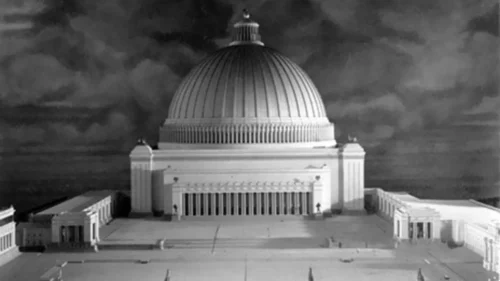
Model for Nazi Volkshalle , Berlin. Albert Speer architect.
The PTSD of today, this generalized feeling of Spectacle fatigue, is expressed in an increasingly base and empty culture. Not just what entertainment has become, but throughout art and culture at all levels. The smart phone habituation is only a symptom of this malaise, which finds expression more profoundly in the streaming of a genocide in Gaza and now Syria. What Gabor Mate called Auschwitz on tiktok. But the decline in overall cultural taste is pronounced. And part of this decline is tied into the work of those deeper readers of Freud, like Klein, like Lacan, like a dozen others. And one of my goals here, if that is how to describe it, is to understand these connections. That our culture no longer knows how to dream seems crucial to the decline in taste and discernment.
“From the mother the infant internalizes the capacity to form visual images out of proto-sensations and proto-emotions, and thus succeeds in personalizing reality, making it subjective and assigning it a personal meaning. Like the cells of the body, those of the psyche also need to be constantly regenerated. The function which governs this activity is the alpha function, the ability to transform sensations in order to create emotionally significant images, not pure perceptions (and it is clear that no perception can be split off from an associated affect). Bion repeatedly uses the verb ‘assimilate’ to differentiate having a consciousness from becoming a consciousness: that is, the innate capacity to perceive stimuli and an understanding based on culture (and these elements are not dissociated). The Self is not achieved once and for all. Dreaming repairs/constructs the psychic skin, the film of meaning which protects us from the impacts of reality, a concept outlined by Freud and later endorsed by other writers. But why dreaming, and not logic or rational thought? Because in my opinion every dream, as ‘poetry of the mind’ (I derive the metaphor from the splendid one in Freud’s paper On Aphasia, 1891), gives the body back to the mind, or rather vice versa reinstates the psyche in the body, constantly seeking to rediscover harmony between body and mind. I picture every successful dream (and what is dreamlike in the session, reverie) exactly as a poem, as something that extends our knowledge of reality, helps us to make it more ambiguous/richer and speaks both to the body through the play of the body of the word, the signifier, and to the mind.”
Giuseppe Civitarese (Ibid)
Screens rob children of time and space for reverie. And without that time and that space the necessary repairs to our psyches are left incomplete. The public today live daily life with open psychic wounds.
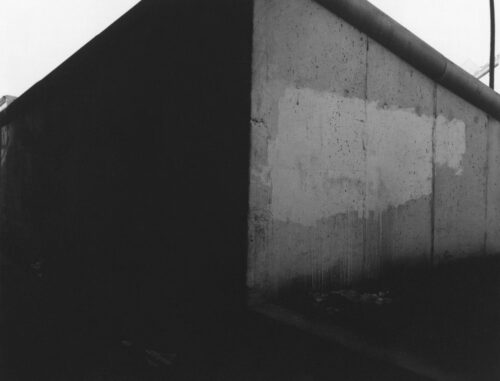
Michael Schmidt, photography.
We are a society of undreamt dreams. And of pseudo dreams. There is a feeling of incompleteness to all of life. It is being substituted for by manufactured crises. The United States gives standing ovations to madmen, cheer and applaud and enable the burning to death of children, to infants dying from exposure, and to naked rank corrupt political organizations. The collective guilt of western society cannot be assuaged. From Auschwitz to Hiroshima, to MK Ultra and School of the Americas, to COINTELPRO. This is the infant stuffing excrement back into the mother. Scientists are working on ice cream made from human excrement, if they aren’t employed by bio-weapon labs. There is no better metaphor than eating shit. Ferenezi wrote an essay based on the nursery school proverb ‘Silence is Golden‘. The psychoanalytic link between silence and the anal eroticism is very resonant.
Martin Luther had his greatest revelation while sitting on the toilet. There are the new Grand Inquisitors; Bill Gates and Netanyahu, Jeffrey Epstein and Keir Starmer, Hunter Biden, Mark Rutte, the Clinton family, and Ursula van der Leyen. The list is very long.
These people want you to eat shit, and to die. That deep lack or hole that triggered the unconscious discourse of civilization also created a system , Capitalism, that destroys and exploits.
“Psychoanalytical studies of the Devil, following Freud himself have emphasized the Oedipal aspect of the Devil, his status as a father-substitute, the ambivalent combination of emulation of and hostility against the father in the Devil, and the identity of God and the Devil (as father-substitutes) underlying their opposition. The persistently anal character of the Devil has not been emphasized enough. The color pre-eminently associated with the Devil and the Black Mass is blacknot because of his place of abode (a circular explanation) but because of the association of black and filth. “The painters paint the Devil black and filthy,” says Luther. Equally persistent is the association of the Devil with a sulphurous or other evil smell, the origin of which is plainly revealed in the article “De crepitu Diaboli” in an eighteenth-century compendium of folklore. The climax of the ritual of the Witches’ Sabbath was to kiss the Devil’s posteriors or a facial mask attached to the Devil’s posteriors. In the central ceremony of the Black Mass, as the Queen of the Sabbath lay prone, “The sacred host was prepared by kneading on her buttocks a mixture of the most repulsive material, faeces, menstrual blood, urine, and offal of “of various kinds.’ Hence Dante makes the still point of the turning world, round which he passes upward to Purgatory, Satan’s anus; hence Bosch, in the panel depicting this world as Hell, enthrones Satan on a privy, from which the souls that have passed out of his anus drop into the black pit.”
Norman O. Brown (Life Against Death)
Society’s mythic narrative ends at a cabin deep in the woods where any of these figures carry out the inquisition. An inquisition. Nazi flags on the walls, or Stars of David, or the flag of the Vatican. Maybe all of them. The cabin is always an abattoir, too. The fairy tale ends in Gaza. In Matamoros. Or behind that jail in Mississippi where 215 bodies were found in unmarked graves.
to donate to this blog use the paypal button at the top of the page. Donations also help support the Aesthetic Resistance podcasts
https://aestheticresistance.substack.com/
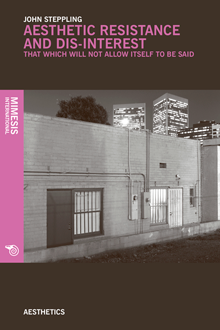
As usual I’m riffing on a few of the themes in this piece.
“There is less resistance to the idea of being an actor in one’s own play, or rather more likely in one’s own movie.”
In the 60s there was a show “The Prisoner” in which Patrick McGoohan played a government agent abducted and installed in a mysterious village where everyone had numbers instead of names. The McGoohan character (“Number 6”) was under constant surveillance. This was presented as an offence to his privacy and his autonomy and he spent the series trying to get out. It strikes me that nowadays everyone wants to get INTO “The Village” (McLuhan’s “global village”?) in the sense that they want to be 24 hour actors in their own dramas. Ironically McGoohan himself hinted at this since the entire 60s series was based on his own idea in which he, of course, was not only constantly in the camera but that very fact of being constantly in the camera was the entire engine that drove the show!
The bit about excrement and how eating shit is a perfect metaphor for our current condition, puts me in mind of a recent horror movie called “The Human Centipede” directed by Tom Six. I haven’t seen, and have no interest in seeing, this move but the plot seemed to me to have a certain metaphorical power. For reasons that are, to say the least, obscure, “a deranged German surgeon … kidnaps three tourists and conjoins them surgically, mouth to anus, forming the eponymous “human centipede”” (from Wiki). The inspiration of the movie is worth quoting:
“According to Six, the concept arose from a joke he had made with friends about punishing a child molester by stitching his mouth to the anus of a “fat truck driver”. Other sources of inspiration were Nazi medical experiments performed during World War II, such as those performed by Josef Mengele at the Auschwitz concentration camp.”
It seems to me significant that the source of inspiration for this dismal notion came from a sense of moral outrage. Echoes of how the atrocities carried out against the Palestinians were fuelled by a constant drone of alleged attacks against Israelis. And the wallowing in the most depraved fantasies are “justified” by this appeal to retribution.
But it struck me that such a “human centipede” is not a bad metaphor for the whole capitalist system in which everyone is forced to eat shit in order to reproduce it in order to re-eat it etc. And the shit produced each time round is increasingly drained of nutrients.
I wonder if there is also a connection with what appears to be the Western fixation with anal sex. There is a scene in Stone’s “JFK” where Jim Garrison (Kevin Costner) visits male prostitute Willie O’Keefe (Kevin Bacon) in prison and O’Keefe says to Garrison, “Your problem is that you’ve never been fucked in the ass!” Of course sodomy has always been taken as a metaphor for being swindled, exploited, etc. It may therefore be taken as a perfect metaphor for capitalism in which it is taken for granted that everyone is trying to “fuck everyone else in the ass”!
it occurs to me these jihadi fighters filming their throat cuttings and stabbings are likely encouraged to do by the CIA AND MOSSAD. This is available to anyone, even children, on social media. Perfect ammunition to use for a program of censorship….which i expect to be coming.
Another series from the canon to talk about is True Detective. At least season one belongs in the canon. One of the protagonists in that tale, Rustin Cohle, repeatedly mentions that he doesn’t sleep, and what I think he really means is that he doesn’t dream anymore. He longs to dream and seeks drugs to do so, but he is too traumatized. By the end of the tale, he feels that he will die while solving his case, and he’s fine with that—a planned, slow suicide.
great comment, dennis. And i think thats exactly right. They made of film of Pizzoletto’s crime novel Galveston which is worth a look. Very overlooked. I was a fan of the much maligned season two as well.-
The Cohle character from True Detective had a philosophy that was inspired by the horror writer Thomas Ligotti whose basic idea was that human consciousness was a kind of evolutionary mistake in which this development of the mind overshot its usefulness and became a curse. The background idea would seem to be a Nietzschean idea that the true nature of the universe is so horrible that we would not be able to withstand a true awareness of it.
This first season of True Detective was a major disappointment ultimately since it seemed to be aiming towards some kind of conspiracy involving top level figures in the police force but this gets dropped for one of the oldest tropes i.e. the backwoods interbred hillbilly psychopath. The Cohle character undergoes a similar reactionary transformation in that he goes from being the nihilist to developing a Christian outlook which is even reflected in his appearance in the hospital with the long hair and, if I recall correctly, his arms outstretched in crucifix fashion.
Totally off topic and arrogant of me but, on discovering that you have little regard for Robert Altman, I’m just jumping on this opportunity to expound on his “Gosford Park” which I just wasted the last two hours of my life watching. It struck me as the usual “whirring” introductory scene whereby the viewer is introduced to a large cast via a lot of movement and snatched conversations and a weaving in and out of various conversations etc. …. only strung out to the entire movie – this giving an impression of watching ships constantly “pass in the night”.
And with an impressive cast …. who are totally wasted. Yes there’s a story there. There’s a murder. There’s a detective brought in – Mr Smug himself, Stephen Fry. But any expectation that he’ll supply some momentum is soon frustrated. There’s a nod to a comic sense that his sidekick is picking up the pieces whilst he himself irritably dismisses this – but that too seems to happen off-centre.
I didn’t realise it was Altman till afterwards. But I recall his “3 Women” as a kinda weird creepy thing that was quite effective. Even the McCabe and Miller one felt more interesting than this one.
Not smart enough to leave a comprehensive comment here, but this post really struck a chord with me.